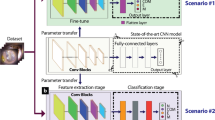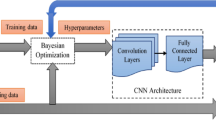Abstract
Otitis media (OM), known as inflammation of the middle ear, is a condition especially seen in children. To carry out a definitive diagnosis of the discomfort that manifests itself with various symptoms such as pain in the ear, fever, and discharge, the eardrum in the middle ear should be examined by a specialist. In this study, a convolution neural network was used for feature extraction from middle ear otoscope images to diagnose different types of OM. These features were extracted using AlexNet, VGG-16, GoogLeNet, ResNet-50 models. The deep features extracted from these models were combined into a new deep feature vector. This feature vector consisting of 4000 deep features was examined, and the most relevant 222 deep features were selected from this large feature set by using the neighbourhood component analysis. In this case, the number of features was decreased and a more effective feature set was obtained. In the next stage of this experimental study, this new feature set was applied as the input to the support vector machine. As a result of the experimental study, an accuracy rate of 79.02% was achieved. The results point out that the use of deep features in detecting OM provides efficient results, and the proposed approach is beneficial in reducing the number of deep features as well as achieving better classification results.








Similar content being viewed by others
Data availability
The dataset used in this study can be accessed via a website: http://www.ctganalysis.com/Category/otitis-media.
References
van den Broek MFL, De Boeck I, Kiekens F, Boudewyns A, Vanderveken OM, Lebeer S (2019) Translating recent microbiome insights in otitis media into probiotic strategies. Clin Microbiol Rev 32(4):e00010-18. https://doi.org/10.1128/CMR.00010-18
Duygu E, Şevik Eliçora S (2020) Our experience on the management of acute mastoiditis in pediatric acute otitis media patients. Int J Pediatr Otorhinolaryngol 138:110372. https://doi.org/10.1016/j.ijporl.2020.110372
van Uum RT et al (2020) Improving pain management in childhood acute otitis media in general practice: a cluster randomised controlled trial of a GP-targeted educational intervention. Br J Gen Pract. https://doi.org/10.3399/bjgp20X712589
Kono M et al (2021) Features predicting treatment failure in pediatric acute otitis media. J Infect Chemother 27(1):19–25. https://doi.org/10.1016/j.jiac.2020.08.003
Barron CL, Kamel-Abusalha LB, Sethia R, Goodman SD, Elmaraghy CA, Bakaletz LO (2020) Identification of essential biofilm proteins in middle ear fluids of otitis media with effusion patients. Laryngoscope 130(3):806–811. https://doi.org/10.1002/lary.28011
Čvorović L et al (2020) Is otitis media with effusion associated with Samter’s triad a new nosological entity? A preliminary report on inflammatory mediator production. Eur Arch Oto-Rhino-Laryngology. https://doi.org/10.1007/s00405-020-06276-1
Isaacson G, Griswold S (2020) Differentiating acute otitis media from otitis media with effusion. Vis J Emerg Med 21:100891. https://doi.org/10.1016/j.visj.2020.100891
Subramaniam V, Ashkar A, Rai S (2020) Cochlear dysfunction in chronic otitis media and its determinants. Iran J Otorhinolaryngol 32(109):79–84. https://doi.org/10.22038/ijorl.2019.35045.2158
Maharjan M, Phuyal S, Shrestha M, Bajracharya R (2020) Chronic otitis media and subsequent hearing loss in children from the himalayan region residing in buddhist monastic schools of Nepal. J Otol. https://doi.org/10.1016/j.joto.2020.09.001
Pontefract B, Nevers M, Fleming-Dutra KE, Hersh A, Samore M, Madaras-Kelly K (2019) Diagnosis and antibiotic management of otitis media and otitis externa in United States veterans. Open Forum Infect Dis. https://doi.org/10.1093/ofid/ofz432
Schwartz RH, (2008) “CHAPTER 32—Otitis Externa and Malignant Otitis Externa,” S. S. B. T.-P. and P. of P. I. D. (Third E. Long, Ed. Edinburgh: W.B. Saunders, pp 230–232
Zafer C (2020) Fusing fine-tuned deep features for recognizing different tympanic membranes. Biocybern Biomed Eng 40(1):40–51. https://doi.org/10.1016/j.bbe.2019.11.001
Goggin LS, Eikelboom RH, Atlas MD (2007) Clinical decision support systems and computer-aided diagnosis in otology. Otolaryngol. Neck Surg. 136(4_suppl):s21–s26. https://doi.org/10.1016/j.otohns.2007.01.028
Myburgh HC, Van Zijl WH, Swanepoel D, Hellström S, Laurent C (2016) EBioMedicine otitis media diagnosis for developing countries using tympanic membrane image-analysis. EBioMedicine 5:156–160
Anupama Kuruvilla1 AHJK, Li2 J, Yeomans1 PH, Quelhas3 P, Shaikh4 N, (2012) “Otitis Media Vocabulary and Grammar,” Media, pp 2845–2848
Huang YK, Huang CP (2018) “A depth-first search algorithm based otoscope application for real-time otitis media image interpretation.” Parallel Distrib Comput Appl Technol PDCAT Proc 2017:170–175. https://doi.org/10.1109/PDCAT.2017.00036
Başaran E,Şengür A, Cömert Z, Budak Ü, Çelık Y, Velappan S, (2019) “Normal and Acute Tympanic Membrane Diagnosis based on Gray Level Co-Occurrence Matrix and Artificial Neural Networks,” in 2019 international artificial intelligence and data processing symposium (IDAP), pp 1–6, https://doi.org/10.1109/IDAP.2019.8875973
Shie CK, Chang HT, Fan FC, Chen CJ, Fang TY, Wang PC, (2014) “A hybrid feature-based segmentation and classification system for the computer aided self-diagnosis of otitis media,” 2014 36th Annu. Int. Conf. IEEE Eng. Med. Biol. Soc. EMBC 2014, pp 4655–4658, https://doi.org/10.1109/EMBC.2014.6944662
Myburgh HC, Jose S, Swanepoel DW, Laurent C (2018) Towards low cost automated smartphone- and cloud-based otitis media diagnosis. Biomed Signal Process Control 39:34–52. https://doi.org/10.1016/j.bspc.2017.07.015
Basaran E, Comert Z, Sengur A, Budak A, Celik Y, Togacar M, (2019) “Chronic Tympanic Membrane Diagnosis based on Deep Convolutional Neural Network,” https://doi.org/10.1109/UBMK.2019.8907070
Başaran E, Cömert Z, Şengur A, Budak Ü, Çelik Y, Toğaçar M, (2020) “Normal ve Kronik Hastalıklı Orta Kulak İmgelerinin Evrişimsel Sinir Ağları Yöntemiyle Tespit Edilmesi,” Türkiye Bilişim Vakfı Bilgi. Bilim. ve Mühendisliği Derg., 13(1), pp 1–10, Accessed: Apr. 26, 2020. [Online]. Available: http://dergipark.org.tr/tr/pub/tbbmd/issue/53711/657649
Cömert Z (2019) Otitis media için evrişimsel sinir ağlarına dayalı entegre bir tanı sistemi. Bitlis Eren Üniversitesi Fen Bilim Derg 8(4):1498–1511. https://doi.org/10.17798/bitlisfen.600636
Başaran E, Cömert Z, Çelik Y (2020) Convolutional neural network approach for automatic tympanic membrane detection and classification. Biomed Signal Process Control 56:101734. https://doi.org/10.1016/J.BSPC.2019.101734
Binol H et al (2020) SelectStitch: automated frame segmentation and stitching to create composite images from otoscope video clips. Appl Sci 10(17):5894. https://doi.org/10.3390/app10175894
Tetila EC et al (2020) Detection and classification of soybean pests using deep learning with UAV images. Comput Electron Agric 179:105836. https://doi.org/10.1016/j.compag.2020.105836
Toğaçar M, Ergen B, Cömert Z (2020) COVID-19 detection using deep learning models to exploit Social Mimic Optimization and structured chest X-ray images using fuzzy color and stacking approaches. Comput Biol Med 121:103805. https://doi.org/10.1016/j.compbiomed.2020.103805
Afshar P, Mohammadi A, Plataniotis KN, (2018) “Brain Tumor Type Classification via Capsule Networks,” Accessed: Apr. 07, 2019. [Online]. Available: http://arxiv.org/abs/1802.10200
Toğaçar M, Ergen B, Cömert Z (2019) Detection of lung cancer on chest CT images using minimum redundancy maximum relevance feature selection method with convolutional neural networks. Biocybern Biomed Eng. https://doi.org/10.1016/J.BBE.2019.11.004
A. Ş. Ümit Budak, Ömer Faruk Alçin, Muzaffer Aslan, (2018) “Optic Disc Detection in Retinal Images via Faster Regional Convolutional Neural Networks,” pp 3–5
Guo Y, Budak Ü, Vespa LJ, Khorasani E, Şengür A (2018) A retinal vessel detection approach using convolution neural network with reinforcement sample learning strategy. Measurement 125:586–591. https://doi.org/10.1016/j.measurement.2018.05.003
Qiao Y, Truman M, Sukkarieh S (2019) Cattle segmentation and contour extraction based on Mask R-CNN for precision livestock farming. Comput Electron Agric 165:104958. https://doi.org/10.1016/j.compag.2019.104958
Roberto GF, Lumini A, Neves LA, Do Nascimento MZ (2021) Fractal Neural Network: a new ensemble of fractal geometry and convolutional neural networks for the classification of histology images. Expert Syst Appl 166:114103. https://doi.org/10.1016/j.eswa.2020.114103
Krizhevsky A, Sutskever I, Hinton GE, (2012) “ImageNet Classification with Deep Convolutional Neural Networks,” In: proceedings of the 25th international conference on neural information processing systems - Volume 1, pp 1097–1105
Szegedy C et al., (2015) “Going deeper with convolutions,” In: 2015 IEEE conference on computer vision and pattern recognition (CVPR), pp 1–9, https://doi.org/10.1109/CVPR.2015.7298594
He K, Zhang X, Ren S, Sun J, (2016) “Deep residual learning for image recognition,” In: proceedings of the IEEE conference on computer vision and pattern recognition, pp 770–778, https://doi.org/10.1109/CVPR.2016.90
Ayyıldız H, Arslan Tuncer S (2020) Determination of the effect of red blood cell parameters in the discrimination of iron deficiency anemia and beta thalassemia via neighborhood component analysis feature selection-based machine learning. Chemom Intell Lab Syst 196:103886. https://doi.org/10.1016/j.chemolab.2019.103886
Ladha L, Deepa T (2011) Feature selection methods and algorithms. Int J Comput Sci Eng 3(5):1787–1797
Guyon I, Elisseeff A (2003) An introduction to variable and feature selection. J Mach Learn Res 3:1157–1182
Yaman O (2021) An automated faults classification method based on binary pattern and neighborhood component analysis using induction motor. Measurement 168:108323. https://doi.org/10.1016/j.measurement.2020.108323
Tuncer T, Dogan S, Acharya UR (2021) Automated accurate speech emotion recognition system using twine shuffle pattern and iterative neighborhood component analysis techniques. Knowledge-Based Syst 211:106547. https://doi.org/10.1016/j.knosys.2020.106547
Yang W, Wang K, Zuo W (2012) Neighborhood component feature selection for high-dimensional data. JCP 7(1):161–168
Iqbal S, Khan MUG, Saba T, Rehman A (2017) Computer-assisted brain tumor type discrimination using magnetic resonance imaging features. Biomed Eng Lett 8(1):5–28. https://doi.org/10.1007/s13534-017-0050-3
Vapnik V (1998) “The support vector method of function estimation”, in nonlinear modeling. Springer, Cham, pp 55–85
Toğaçar M, Ergen B, Cömert Z (2020) Classification of flower species by using features extracted from the intersection of feature selection methods in convolutional neural network models. Measurement 158:107703. https://doi.org/10.1016/J.MEASUREMENT.2020.107703
Amyar A, Modzelewski R, Li H, Ruan S (2020) Multi-task deep learning based CT imaging analysis for COVID-19 pneumonia: classification and segmentation. Comput Biol Med 126:104037. https://doi.org/10.1016/j.compbiomed.2020.104037
Kermany DS et al (2018) Identifying medical diagnoses and treatable diseases by image-based deep learning. Cell 172(5):1122-1131.e9. https://doi.org/10.1016/j.cell.2018.02.010
Li S, Song W, Qin H, Hao A (2018) Deep variance network: an iterative, improved CNN framework for unbalanced training datasets. Pattern Recognit 81:294–308. https://doi.org/10.1016/J.PATCOG.2018.03.035
Marom T, Bobrow M, Eviatar E, Oron Y, Ovnat S (2017) Adherence to acute otitis media diagnosis and treatment guidelines among Israeli otolaryngologists. Int J Pediatric Otorhinolaryngol 95:63–68
Binol H et al., (2020) “Decision fusion on image analysis and tympanometry to detect eardrum abnormalities,” In Medical Imaging 2020: Computer-Aided Diagnosis, 2020, 11314, pp 375–382, doi: https://doi.org/10.1117/12.2549394
Uçar M, Akyol K, Atila Ü, Uçar E (2021) Classification of different tympanic membrane conditions using fused deep hypercolumn features and bidirectional LSTM. IRBM. https://doi.org/10.1016/j.irbm.2021.01.001
Funding
There is no funding source for this article.
Author information
Authors and Affiliations
Corresponding author
Ethics declarations
Conflict of interest
The authors declare that there is no conflict of interest related to this paper.
Ethical approval
This article does not contain any data or other information from studies or experimentation, with the involvement of human or animal subjects.
Additional information
Publisher's Note
Springer Nature remains neutral with regard to jurisdictional claims in published maps and institutional affiliations.
Rights and permissions
About this article
Cite this article
Başaran, E., Cömert, Z. & Çelik, Y. Neighbourhood component analysis and deep feature-based diagnosis model for middle ear otoscope images. Neural Comput & Applic 34, 6027–6038 (2022). https://doi.org/10.1007/s00521-021-06810-0
Received:
Accepted:
Published:
Issue Date:
DOI: https://doi.org/10.1007/s00521-021-06810-0




